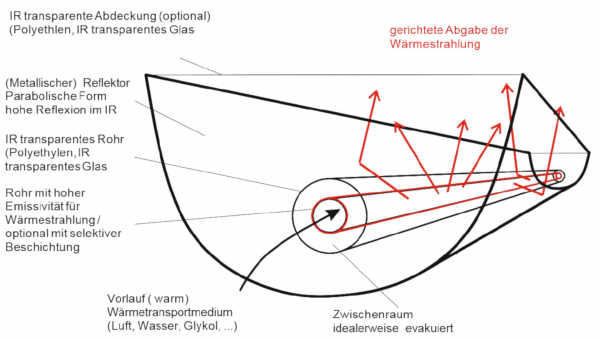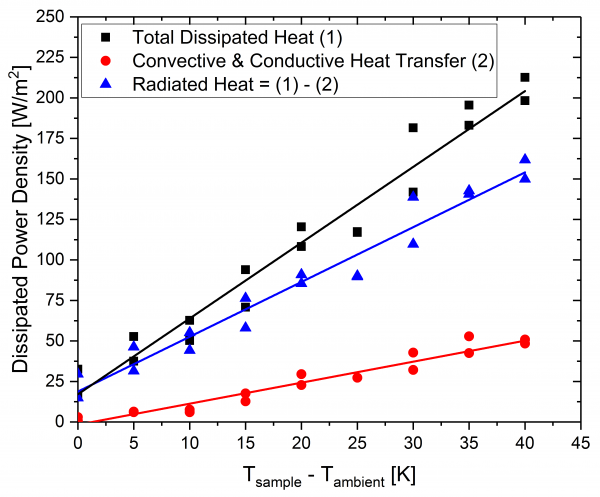Photonic Cooling – Efficient cooling of buildings through the use of photonic
Short Description
Within the scope of the project a photonic cooling approach was investigated and evaluated in terms of feasibility and cost efficiency for building applications. In particular cost-efficient photonic surfaces and concepts were investigated which need to have a high reflectivity in of the incident solar radiation (>97%) and a high emission coefficient within the spectral range of 8 – 13 micrometer in order to enable the emission of heat into the sky. Based on these requirements, different approaches utilizing photonic cooling concepts in particular for cooling of buildings were developed and potential reductions of the electric power required for cooling are estimated. In addition, potential mitigation effects of the photonic cooling approach on the overheating of cities were modelled. The main aim of the project was to create reliable knowledge regarding the feasibility of photonic cooling approaches for air-conditioning applications and whether the approach can contribute to an improvement of quality of life in cities of tomorrow.
Starting point / motivation
In the wake of climate change and the rising number of heat islands in urban landscapes, energy expenses for air conditioning, especially during the summer, will increase dramatically. The waste heat generated by additionally installed air conditioners will worsen the micro climate even more, thereby negatively affecting health and quality of life of citizens. Innovative cooling concepts that do not additionally require electrical power might be also a way to lower the costs for cooling.
In this context, the aim of the project "Photonic Cooling – Efficient cooling of buildings through the use of photonic" was to evaluate the suitability of the Photonic Cooling technology to reduce the occurrence and the size of urban heat islands and to lower the power consumption due to air conditioning.
Contents and Goals
Another requirement within the Photonic Cooling approach is the usage of radiation cooling in particular on sunny and clear days. Radiation cooling during daytime is challenging, as in general more heat is absorbed by the cooling system through solar irradiation and heat transfer from the ambient air than radiated off into space. Even though the basic approach of radiation cooling has been pursued for quite some time, the experimental implementation of devices with substantial cooling power yields has been successful only recently. This can be attributed to the continuously ongoing advancements in technology and to an improvement of know-how concerning the physics behind (nano-) optical and photonic structures.
Methods
There were and still are many open questions with respect to the realization of such devices: For instance, cost efficient fabrication techniques for the required surface coatings needed to be found; sophisticated concepts concerning the integration of the cooling devices into a building architecture had to be developed; and finally, a decisive proof was required for the claim that photonic cooling can provide noticeable cooling power yields that also might contribute to a reduction of urban heat islands. All these subjects were addressed within this project and the obtained results provide a clarification regarding the feasibility of some photonic cooling concepts as well as their practical implementation.
Results
In summary, the following results were achieved:
Quantification of the impact of air conditioning waste heat on urban microclimate, electricity consumption and greenhouse gas (GHG) emissions
Within the project "Photonic Cooling", a relation between waste heat generated by air conditioning and an increase of urban temperature was derived with the intention to estimate the impact of this anthropogenic heat release on urban climate. Based on measurements of electricity consumption and the maximum degree of cooling for the period 2009 – 2016, the employed simulation model allowed for an estimation of the influence on the urban climate due to the waste heat generated by air conditioning. Additionally, the model provided also a prognosis of the situation in 2050 for the city of Vienna. The results derived from this model indicate that the electrical energy used for cooling will increase from currently 22 GWh/year to 95 (33 - 189) GWh/year by 2050. In addition, socio-economic models predicting energy consumption by air conditioning in cities have been developed.
Photonic Cooling
In the area of photonic cooling technology, efficient functional models have been realized with low-cost and commercially available materials. Their radiation performance has been determined through experiment and a patent was filed for these functional photonic cooling models. However, one of the main conclusions drawn from a SWOT analysis is that there is no medium-term commercial potential for exploiting photonic cooling.
The economic potential of Photonic Cooling can only be exploited on a long-term scale in combination with other innovative cooling concepts. Another consequence of this conclusion is that there is no urgent need for further exploitation activities in the current situation. Concluding, the potential for exploitation of photonic cooling is only on a long-term scale while the photonic cooling technology can only work in combination with air conditioning systems, which are significantly different from today's standard systems.
Use of photonics cooling for building cooling / energy saving in the building
For the first time, application scenarios of photonic cooling technology in building technology were analyzed and the potential energy savings were determined. In summary, the results from 4 different applications show that the remarkably positive properties of photonic cooling technology can only be used in areas having a cloud-free sky and a low humidity on most days of the year. The cooling surface of the photonic cooling technology has to be significantly improved by appropriate research efforts in order to improve the achieved cooling yield in general as well as the specific emission power yields within the infrared regions in particular. In addition, the thermodynamic behavior of the photonic cooling surface has to be investigated in more detail providing a more comprehensible guideline for future applications.
Prospects / Suggestions for future research
For the first time, the potential of photonic cooling in order to improve the urban microclimate was assessed in detail. Estimates of future anthropogenic heat emissions and their resulting increase in urban temperatures were considered as a function of the air conditioning penetration rate and for future temperatures. As the effect of anthropogenic heat release on urban temperatures was estimated based on a literature study, in the present study only information related to the maximum temperature effect is presented, but no information regarding the local distribution of the temperature maximum as well as the spatial extent of such effect can be deduced. However, this shortcoming can be overcome by a direct modelling approach of such conditions enabling a more detailed analysis. With regard to the practical implementation of photonic cooling technology, no application having a short- or medium-term commercial exploitation potential could be identified.
However, the project results further raise a number of interesting questions that should be examined in future R&D projects. These questions include on the one hand the investigation of the local heat island affected by waste heat generated by air conditioning on a decreased scale and for alternative city designs (construction). Furthermore, R&D activities concerning the realization and characterization of photonic cooling functional models have to be pursued in order to enable their integration into upcoming and innovative cooling systems.
Project Images
Terms of use: The pictures listed underneath the header “Project Pictures” originate from the projects in the frame of the programmes City of Tomorrow, Building of Tomorrow and the IEA Research Cooperation. They may be used credited for non-commercial purposes under the Creative Commons License Attribution-NonCommercial (CC BY-NC).
Publications
Paper
- Estimating the daily peak and annual total electricity demand for cooling in Vienna, Austria by 2050 (Urban Climate Volume 28, June 2019)
Project Partners
Project management
JOANNEUM RESEARCH Forschungsgesellschaft mbH
Project or cooperation partners
Zentralanstalt für Meteorologie und Geodynamik
Contact Address
Dr Gerhard Peharz
Franz-Pichler-Strasse 30
Tel.: +43 (316) 876 3205
E-mail: Gerhard.peharz@joanneum.at
Web: www.joanneum.at





